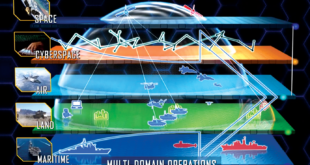Avionics are the electronic systems used on aircraft. Aircraft avionics is the most crucial component of aircraft systems and helps in providing various operational and virtual information in-flight and on the ground. The avionics system receives data from the air traffic management system and feeds this information to the pilot …
Read More »Monthly Archives: October 2022
Multimedia frameworks used to create media applications (streaming, media playback, non-linear editing, etc.)
Multimedia includes media text, audio, still image, video, and metadata. These files need to be acquired for example through the camera, then stored on the hard drive, along with compression, searched by description, played, and edited for example video editing. A multimedia framework is a software framework that handles …
Read More »Communication networks technology trends and Market
A communication network in its simplest form is a set of equipment and facilities to provide service by transfer of information between users located at various locations. Communication networks have evolved from telegraph networks that operated at tenths of bits per second to modern optical systems, which are operated …
Read More »Consumer electronics technologies, trends and market
Technology has changed the world that we live in. Businesses have taken advantage of advances in technology in a multitude of ways, usually as a way to increase productivity or decrease operating costs. Consumer technology has made its way to the forefront of technical applications due to it’s incredible potential …
Read More »US Army’s NGIA integrating multiple domain sensors for situational awareness
The United States Special Operations Command (USSOCOM or SOCOM) is the Unified Combatant Command charged with overseeing the various Special Operations Component Commands of the Army, Marine Corps, Navy, and Air Force of the United States Armed Forces. USSOCOM conducts several covert and clandestine missions, such as direct action, special …
Read More »GPS III and NTS-3 Satellites will provide higher acccuracy, jam resistance, and new navigation warfare (NAVWAR) capabilities to US DOD
The Global Positioning System (GPS), is a global navigation satellite system (GNSS) that provides location and time information in all weather conditions, anywhere on or near the Earth where there is an unobstructed line of sight to four or more GPS satellites. GPS has become ubiquitous technology that provides real-time …
Read More »Avionics software planning and development process and standards
Contemporary aircraft, both civilian and military, are equipped with various radio–electronic onboard devices, which support a pilot in executing complex air missions. The rapid development of digital electronics and IT, increasingly distinct over the recent years, requires a pilot of a modern aircraft to have the in-flight support of onboard …
Read More »Augmented Reality Systems for soldiers are set to Revolutionize Battlefield Operations by drastically improving the situational awareness & decision-making
Military to succeed in their missions, require a robust, multi-faceted picture of their operational environments, including the location, nature and activity of both threats and allied forces around them. Warfare is becoming increasingly networked, so finding an effective way to quickly display the deluge of information available, in an easily …
Read More »Human to Machine Interface (HMI) for controlling Autonomous Killer Satellites
The US China, and Russia have also reportedly developed so-called “inspection satellites” that can maneuver close to other spacecraft in low orbits and examine them for malfunctions. The robots could fix minor maintenance issues, keeping up with current orbiters as they age and sustain damage. However, this technology is …
Read More »CBRN Defense Industry and market
The threats of chemical, biological, radiological, nuclear and explosive (CBRNE) hazards continue to advance. According to the University of Maryland’s Global Terrorism Database, there were a total of 143 attacks – 35 biological, 95 chemical, and 13 radiological – using CBRN weapons across the world from 1970 to 2014. The …
Read More » International Defense Security & Technology Your trusted Source for News, Research and Analysis
International Defense Security & Technology Your trusted Source for News, Research and Analysis







